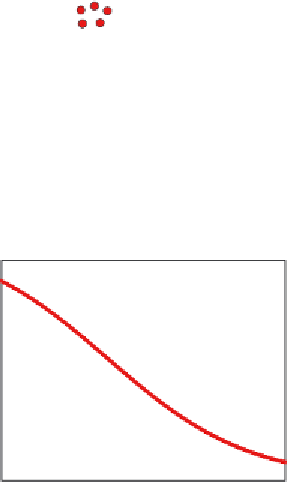Biology Reference
In-Depth Information
A RED type of cell
synthesises red molecules
A GREEN type of cell
synthesises green molecules
A cell can change type
with a probability P which depends on
the concentrations of red or green
molecules in its environment
When x (concentration of molecules)
increases, owing to cell activity,
P decreases until the cell is stabilised
F
IGURE
23. Characteristics of simulations of the Darwinian model of differentia-
tion.
The probability p for a cell of changing type at a given moment is a function
F(X), X being the concentration of molecules in the cell environment at this
moment. This function depends on two parameters β and C
0
. β allows the slope of
the function to be varied (examples: the blue, green and red graphs are obtained
for various values of β with C
0
constant). C
0
allows the value X to be changed for
p ≈ ½ (examples: the green and black graphs are obtained for two different values
of C
0
, with β constant). Depending on the values of β and C
0,
the cells are stabilised
at different molecular concentrations. The simulations are also controlled by a
series of parameters the values of which may be changed: rate of synthesis of the
molecules, rate of degradation, speed of diffusion of the molecules. During a sim-
ulation, cells stabilise in a type when the concentrations of red and green mole-
cules increase. The aim of the simulation is to find out whether the states of
equilibrium generated for the system produce organised structures with properties
relevant for a biological system.
type), and the simulation continues according to the rules defined
until the population of cells is possibly completely stabilised.
In both cases the population evolves towards a stable state, but
as can be seen, interstabilisation and autostabilisation exert very





































